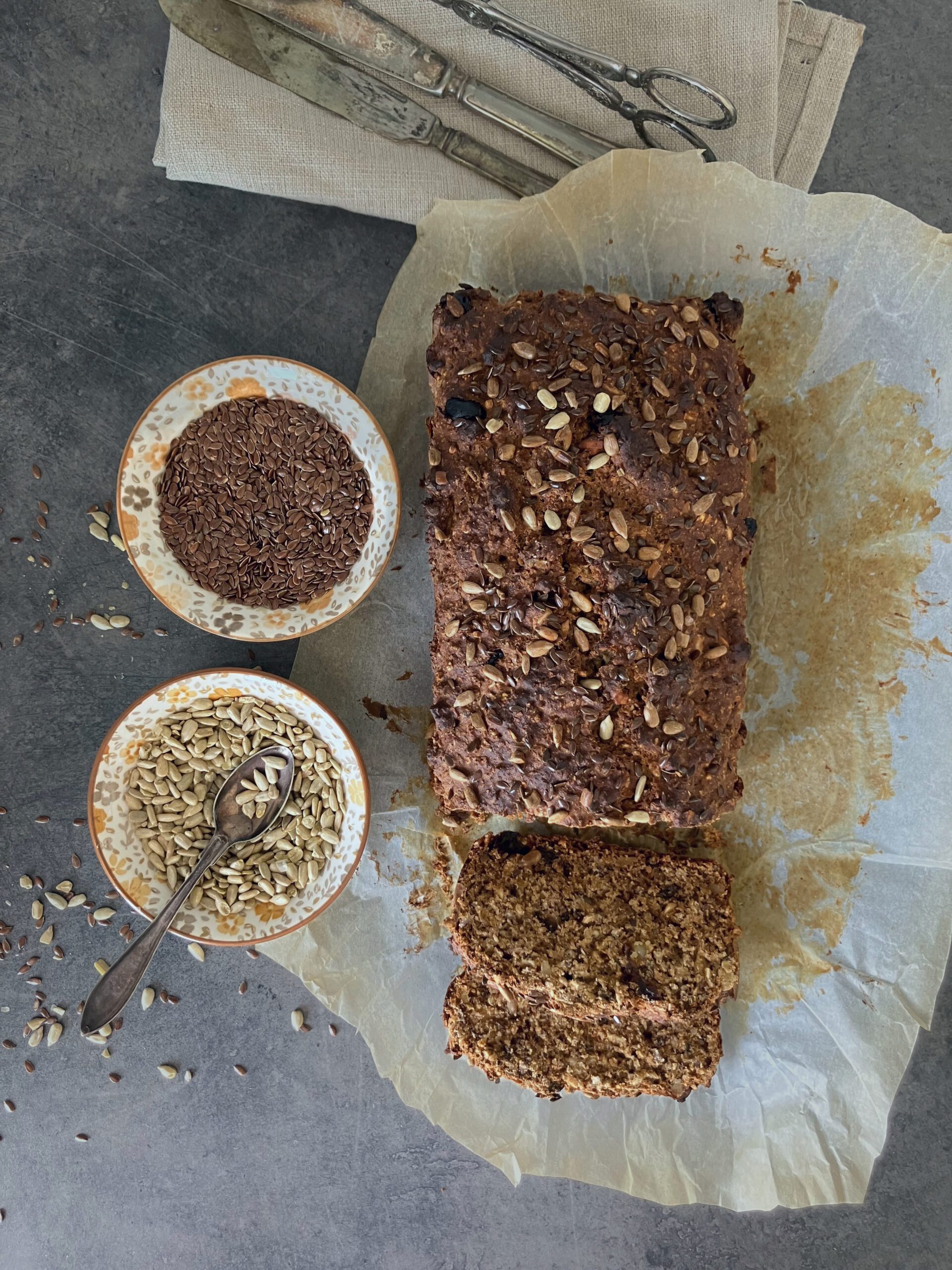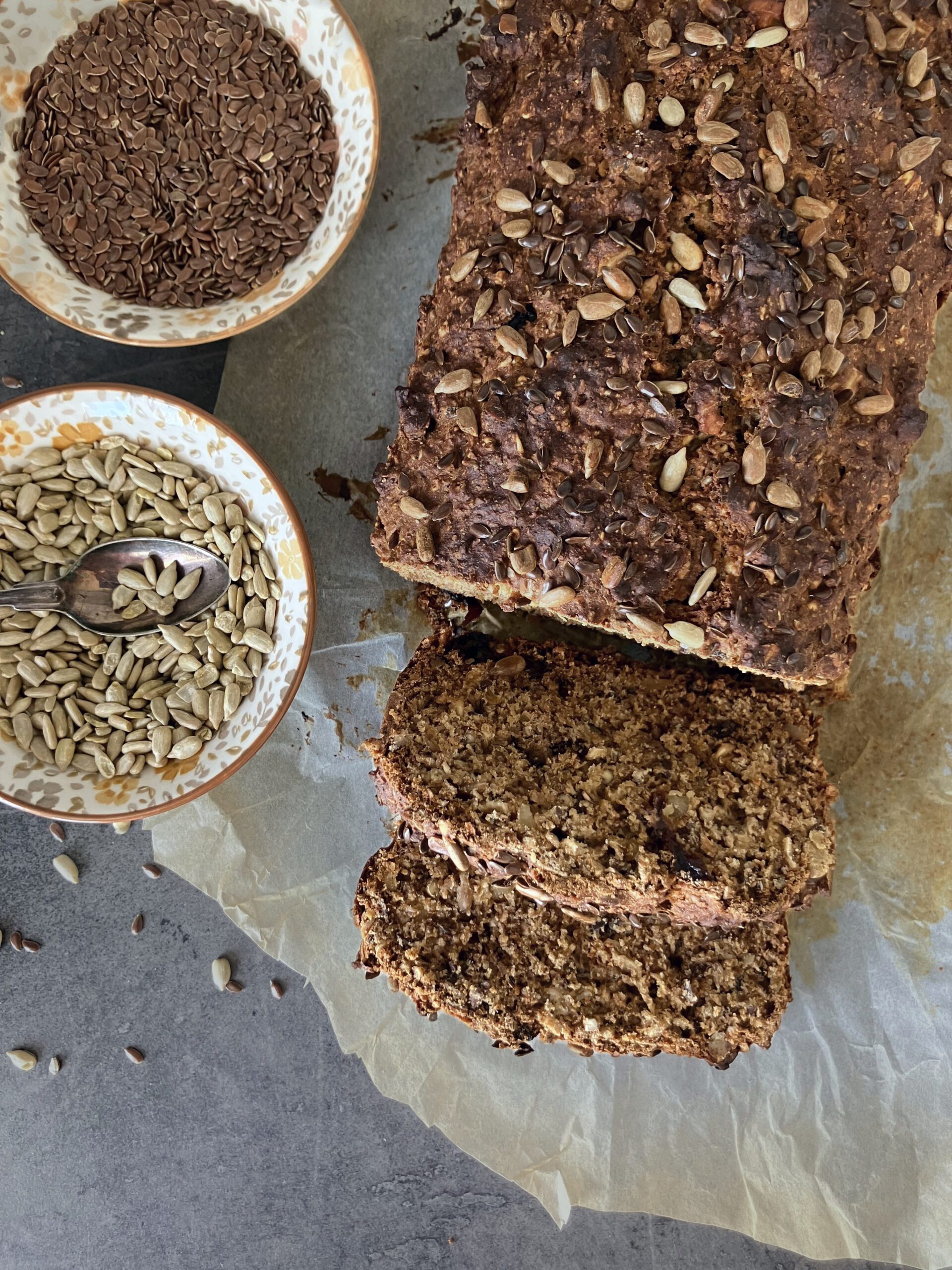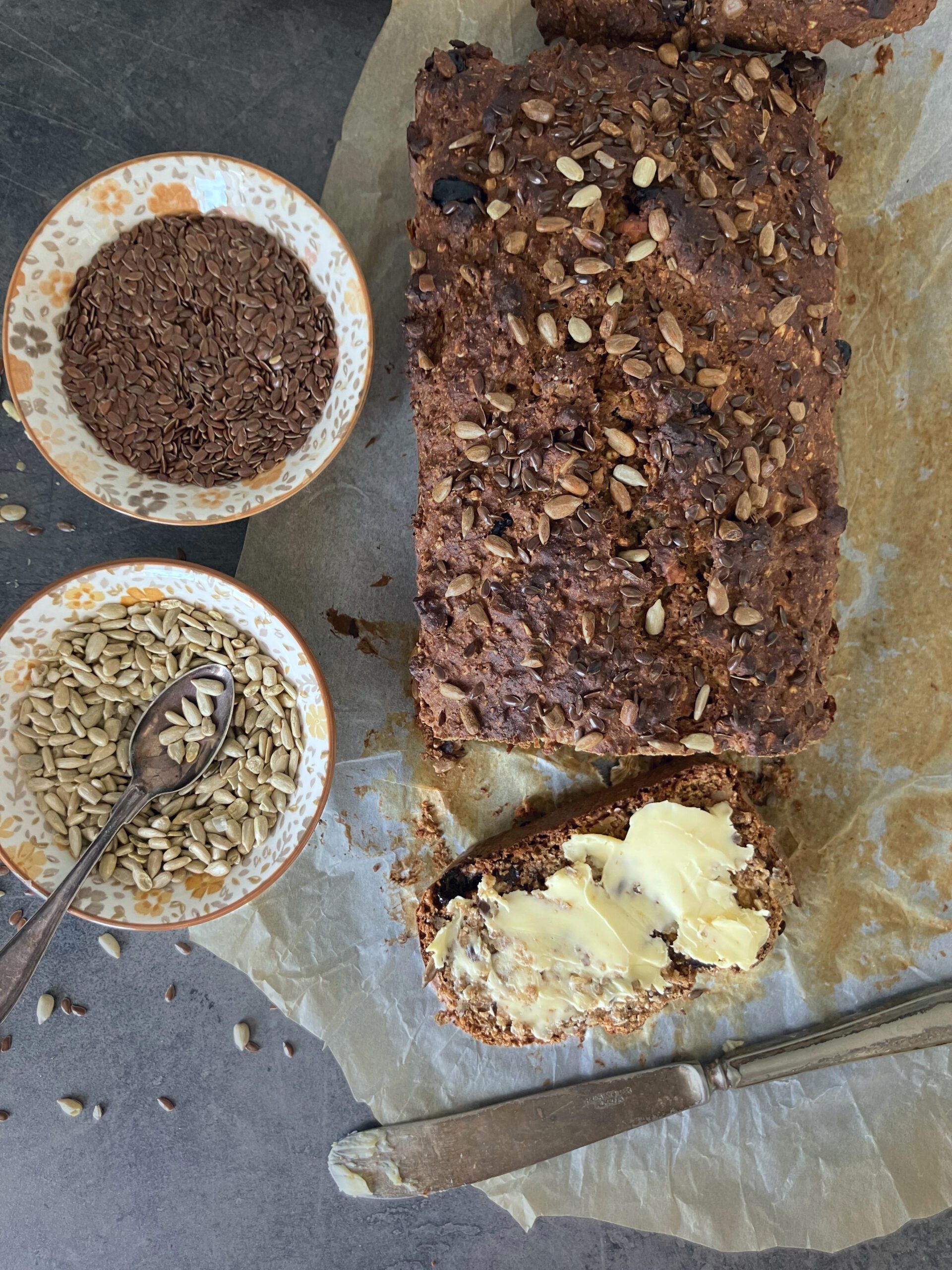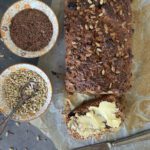Swedish Rye and Wholegrain Seed Bread
“I love this recipe! We came home after a trip to Sweden and I couldn’t stop dreaming of all the delicious rye breads we ate. This recipe is absolutely what I was looking for! I was also able to find filmjölk at my local market too which really does make this extra delicious.”
★★★★★
Swedish rye seeded bread
This Swedish rye and wholegrain seed bread is the epitome of healthy bread. Rye and seeds are only the beginning of the long list of ingredients thrown in to make this dark, dense seed bread.
This Swedish rye and wholegrain seed bread comes from Receptfavoriter and is a traditional bread recipe. I have tweaked it a little to suit my preferences. The list of ingredients is long, but if you can get hold of them all, it is worthwhile. There’s everything from walnuts to raisins, along with various different kinds of wholegrain and seeds.
Some of the ingredients are very Swedish, so in this post, I will give easier to find alternatives so that you can make this bread wherever you are in the world.
Why Swedes love a good rye bread
Swedes love a good rye bread, especially for special occasions. There’s something deeply traditional and comforting about a dense, flavourful loaf packed with grains, seeds, and just a touch of sweetness. But it’s more than just a taste preference; rye bread has deep roots in Swedish food culture.
Historically, rye was one of the few grains that could thrive in Sweden’s cold climate and shorter growing season. For centuries, it was a staple in rural households, baked into hearty loaves that could keep well through long winters. That connection to tradition remains strong today, and rye bread is still seen as a wholesome, reliable presence on the table, especially during holidays and family gatherings.
I made this particular loaf for my son’s graduation recently, and again for Midsommar last week, and both times it was the first thing to disappear from the table. It’s rich and hearty, but not heavy, and it slices beautifully. This makes it perfect for topping with deliciously classic Swedish favourites like sliced egg or gravad lax (dry-cured salmon, usually flavoured with dill, sugar, and salt). All you need to add is a sprig of dill, and maybe a dab of mustard sauce, and you’ve got something that tastes unmistakably Swedish.
Simple, no-knead and yeast-free bread
As mentioned above, this is exactly the kind of rye bread Swedes love, not just for its flavour and place at the table, but for its straightforward, practical nature. Beyond tradition and taste, there’s something very typically Swedish about this loaf: it’s wonderfully practical.
Swedes tend to favour recipes that are no-nonsense and reliable, delivering great results without unnecessary fuss or complicated steps. This rye bread fits that philosophy perfectly. Made from simple, wholesome ingredients you likely already have in your pantry such as rye and wholegrain flours, oats, seeds, nuts, and a touch of dark syrup. It’s a recipe that embraces everyday practicality without sacrificing flavour.
What makes this bread especially appealing is that it requires no kneading or rising time. There’s no need to plan your baking schedule around proving dough or managing sticky kneading sessions. Instead, you simply mix the Greek yoghurt and milk with syrup, then add the flours, grains, seeds, nuts, and spices all in one bowl. There’s no yeast either. The bread remains fairly dense but is given a little boost by the baking soda.
Simply stir everything together until just combined, pour the mixture into a lined loaf tin, and bake. In about 40 to 45 minutes, you’ll have a dense, hearty loaf with a beautiful crust, packed with texture and just the right balance of sweetness and earthiness. It’s the kind of bread that’s as easy to make as it is satisfying to eat.
Flour and grain substitutions
This bread gets its distinct texture and deep flavour from a classic Swedish-style mix of flours and grains. If you’re in Sweden, ingredients like grahamsmjöl (graham flour), rågmjöl (rye flour), and rågkross (cracked rye) are easy to find. But if you’re baking outside Sweden, here are a few notes and substitutions to help you recreate the loaf with what’s available to you:
- Graham flour is a coarsely ground whole wheat flour that adds texture and fibre. If you can’t find it, regular whole wheat flour works just fine. For a closer match, you could add a spoonful of wheat bran or wheat germ to mimic the texture.
- Cracked rye adds a lovely bite and rustic chew to the loaf. If unavailable, try cracked wheat, steel-cut oats, or even rolled oats. The aim is to add some texture and grainy substance.
- Rye flour gives the bread its earthy, slightly sour flavour and is essential to that traditional Swedish profile. Light, medium, or dark rye all work. If you don’t have rye flour, whole wheat flour can be used in its place, though the flavour will be less distinct.
- Wholegrain spelt flour brings a gentle nuttiness and softness to balance the denser grains. If you don’t have spelt, substitute with whole wheat flour. The texture might vary slightly, but it will still bake up beautifully.
- Oats help hold moisture and contribute to the hearty feel. Use rolled or porridge oats, not instant, for the best results.
Even if you need to swap out a few ingredients based on what’s in your cupboard, the recipe is forgiving, and very much in the spirit of everyday Swedish baking.
Swedish bread spice (brödkrydda)
One of the little touches that gives Swedish rye bread its distinct flavour is brödkrydda, a traditional bread spice blend often used in darker, denser loaves. It usually includes a mix of ground caraway, fennel, and aniseed, sometimes with coriander. The result is subtly aromatic, warm, and earthy, complementing the richness of rye flour beautifully.
If you’re outside of Sweden and can’t find a ready-made bread spice mix, you can make a simple version yourself. Try using:
- ¼ tsp ground caraway
- A pinch each of ground fennel and aniseed
Feel free to adjust the proportions to taste, or leave the spice out altogether if you prefer a plainer loaf. The bread will still be delicious, just slightly milder in flavour.
Bread syrup (brödsirap) and how to replace it
Swedish brödsirap is a thick, dark syrup made from sugar beet, and it’s a common ingredient in traditional wholegrain and rye breads. It adds moisture, richness, and a hint of sweetness that balances out the tangy, earthy ingredients.
There are two main types of brödsirap: light and dark. For this kind of bread, dark syrup is typically used, as it deepens both the flavour and the colour of the loaf. If you can’t get hold of brödsirap, don’t worry, as plenty of alternatives work just fine:
- Molasses – the closest substitute in both taste and consistency
- Dark treacle – slightly stronger but still a great option
- Barley malt syrup or brown rice syrup – milder but work well for moisture
- Honey or maple syrup – lighter in flavour, but suitable in a pinch
Whichever you choose, the syrup helps give the bread its soft texture and subtle sweetness without making it sugary.
From filmjölk to Greek yoghurt: adapting a Swedish classic
The original version of this bread is made with filmjölk, a cultured milk product that’s a staple in many Swedish kitchens. Slightly tangy, thick but pourable, and mildly fermented, it’s somewhere between yoghurt and buttermilk in both texture and taste. It adds a soft acidity to the dough, helps the bread rise a little (even without yeast), and contributes to that moist, tender crumb that makes this type of loaf so satisfying.
I didn’t have any filmjölk on hand, so I adapted the recipe using a mix of Greek yoghurt and milk. The yoghurt gives the slight tang and body, while the milk thins the mixture to a consistency closer to filmjölk. It works beautifully and results in a moist, well-balanced bread with just the right density.
If you’re not using filmjölk, here are a few other combinations that will also do the job:
- Buttermilk – probably the closest substitute
- Plain kefir – another fermented dairy product that mimics the flavour and consistency
- Natural plain yoghurt – thinned with a little water or milk
- Soured milk – stir a tablespoon of lemon juice or vinegar into regular milk and let it sit for 5–10 minutes before using
The key is to have something slightly acidic to react with the bicarbonate of soda and give the loaf a little lift, while also helping to develop that deep, slightly tangy flavour Swedes associate with classic rye bread.
Adding texture: fruits, nuts, and seeds
The original recipe for this rye bread included a mix of figs, hazelnuts, and raisins. Dried fruit and nuts are traditional additions to festive breads in Sweden, often giving a celebratory feel without being overly rich.
For my version, I kept it a little simpler: I used just raisins and chopped walnuts. The raisins add gentle bursts of sweetness throughout the loaf, while the walnuts bring a satisfying crunch and an earthy depth that works beautifully with the rye and spices. If you’re feeling adventurous, or want a slightly fruitier loaf for a special occasion, feel free to reintroduce the figs or try chopped dried apricots or dates.
There are also linseed and sunflower seeds in the bread. They help round out the flavour and add a bit of chew, making each bite more interesting. You could easily substitute or add in other seeds like pumpkin (which are in the original recipe), flaxseeds, chia or even sesame if you prefer. A scattering on top before baking also gives the crust a lovely rustic finish.
Swedish Rye and Wholegrain Seed Bread
Ingredients
- 125ml (½ cup) Greek yoghurt (see note 1)
- 100ml (¼ cup + 3 tbsp) milk
- 50ml (3 tbs + 1 tsp) bread or dark syrup (see note 2)
- 30g (¼ cup) graham flour
- 30g (¼ cup) cracked rye
- 30g (¼ cup) oats
- 75g (½ cup + 1 tbsp) rye flour
- 60g (½ cup) wholegrain spelt flour (see note 3)
- 30g (¼ cup) bread flour
- 25g (2½ tbsp) linseeds (see note 4)
- 25g (2½ tbsp) sunflower seeds kernels (see note 4)
- 1 teaspoon salt
- 1 teaspoon baking soda
- 1 teaspoon bread spice (see note 5)
- 25g (3½ tbsp) chopped walnuts (see note 6)
- 25g (2½ tbsp) raisins
Instructions
- Pre-heat the oven to 200℃ (400℉). Line a regular loaf pan with baking paper.
- Mix the Greek yoghurt, milk and syrup together in a large bowl.
- Add the remaining ingredients to the wet and stir until combined.
- Pour into the prepared tin and smooth over with a knife to roughly flatten the top. Sprinkle some seeds over the top.
- Bake in the oven for around 40-45 minutes. Allow to cool in the pan for a while, then turn out onto a rack. Enjoy!
Notes
- If you do have access to filmjölk, use 225ml (1 cup) and do not add any milk or Greek yoghurt. Further substitution ideas can be found here.
- If this is not available, use any dark syrup (such as molasses or treacle) would work well. See here for other substitutions.
- You can substitute regular wholegrain flour for wholegrain spelt. Read here for more help with subbing flours.
- You can use any seeds you like - pumpkin and poppy seeds also work well.
- Bread spice is a special blend of spices to add to bread. Please read for more information.
- Walnuts are great in this recipe, but you can omit them, or use any other kind of nut.
6 thoughts on “Swedish Rye and Wholegrain Seed Bread”
Leave a Reply









I love this recipe! We came home after a trip to Sweden and I couldn’t stop dreaming of all the delicious rye breads we ate. This recipe is absolutely what I was looking for! I was also able to find filmjölk at my local market too which really does make this extra delicious.
Hi Kyle! So glad you enjoyed it – Swedish breads are amazing, and so easy to make (and how awesome that you managed to find some filmjölk)!
What can I really say apart from I adore this recipe! I’ve been on the hunt for a versatile, convenient, nutritious and hearty rye bread recipe, and I must say this ticks all the boxes. What I love most is that you can pull different levers to make the bread more earthy or sweet depending on your preferences – very impressed!
Many thanks for the recipe and the beautifully explained insights about Swedish baking traditions and ingredient substitutions. Peace and love!
Thank you SO, much Karim! It’s a favourite of mine, too (and as you say, highly adaptable), so I am glad you like it!